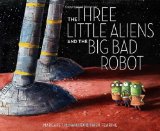Review of Exclamation Mark, by Amy Krouse Rosenthal & Tom Lichtenfeld
!
by Amy Krouse Rosenthal & Tom Lichtenheld
Scholastic Press, New York, 2013. 52 pages.
Starred Review
It’s impossible for me not to love this book. It’s not even for my main audience — the preschool story time crowd. It is for kids in early elementary school who are learning about punctuation. And it’s simply perfect. Those kids are not the only ones who will love this book.
The expression of this story is completely visual. It plays out on the background of school writing paper. We’ve got a row of periods with little faces — and one exclamation mark.
He stood out from the very beginning.
It’s easy for the reader to see that the exclamation mark doesn’t fit in. He is different. He tries to be like his friends. But he becomes confused, flummoxed, and deflated, with appropriate illustrations of his top part in a twist.
Then one day, he meets a question mark.
The question mark asks one question after another. (Hilarious questions, I might add.)
When the exclamation mark shouts for him to stop, it is indeed an exclamation.
He didn’t know he had it in him.
He then explores his newly discovered power. I love the way the question mark eggs him on, always with questions (“How’d you do that? Can you do it again?”)
His exclamations get more and more excited, colorful, and all over the page. “It was like he broke free from a life sentence.”
Question mark: “Isn’t he something?”
Periods: “There was never any question in our minds.”
Okay, as I write this, it occurs to me that maybe I love this book so much because I love puns. In a sense, this whole book is a pun, done perfectly. And it’s a happy story about being an individual and making your mark. And it teaches about punctuation in a way no kid will ever forget. Hmm. Is that why they call it pun-ctuation? (Sorry.)
Way too much fun!
whoisamy.com
tomlichtenheld.com
scholastic.com
Find this review on Sonderbooks at: www.sonderbooks.com/Picture_Books/exclamation_mark.html
Disclosure: I am an Amazon Affiliate, and will earn a small percentage if you order a book on Amazon after clicking through from my site.
Source: This review is based on a library book from the Fairfax County Public Library.
Disclaimer: I am a professional librarian, but I maintain my website and blogs on my own time. The views expressed are solely my own, and in no way represent the official views of my employer or of any committee or group of which I am part.









